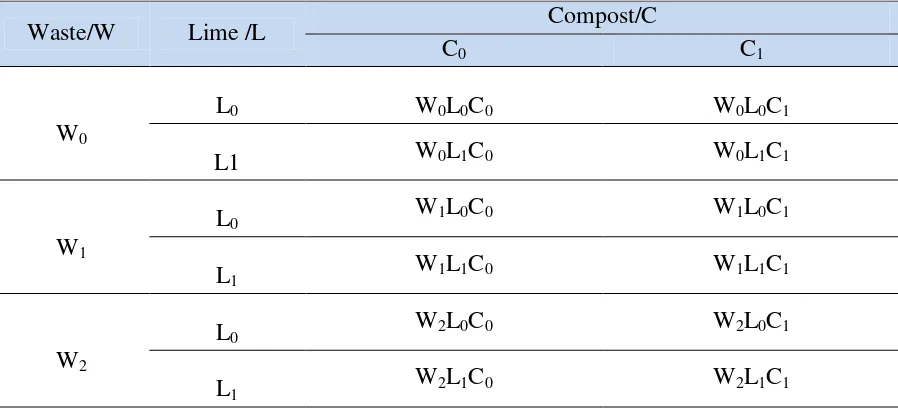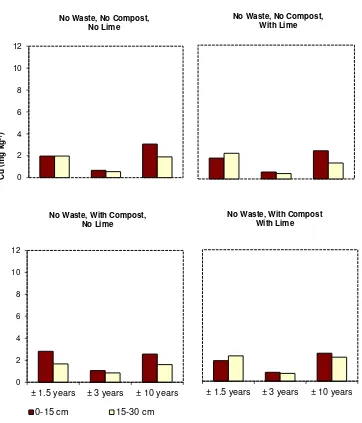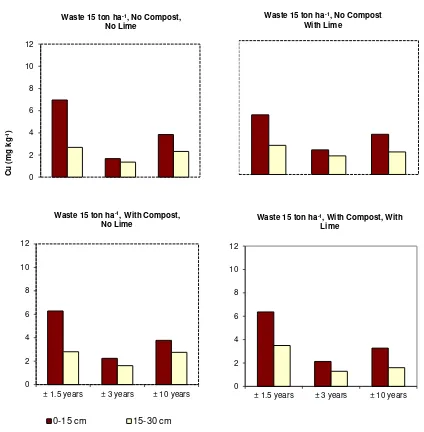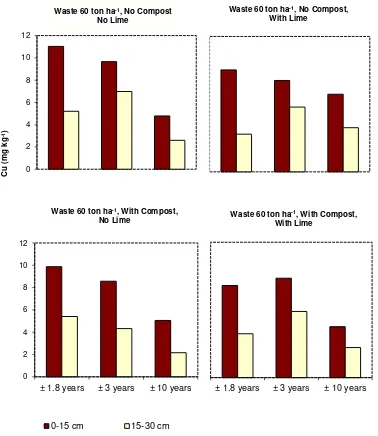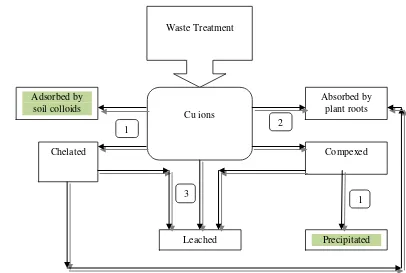Treatment with Copper-Containing-Waste
2
3
Abdul Kadir Salam* dan Kiat Ginanjar 4
Faculty Staff* and Alumnus 5
Department of Soil Science University of Lampung 6
Bandar Lampung Indonesia 35145 7
8
*Corresponding Author 9
10
Fax. 0721-8011325 11
12
Abstract
1
Copper is reported to be retained in soils for a quite long time particularly in soil treated with some 2
amendments. This research was intended to evaluate the soil labile fractions of Cu ±10 years after 3
treatments with Cu-containing industrial waste, lime, and cassava-leaf compost. Soil samples were 4
taken from topsoils and subsoils of ±10 years old experimental plots set in 1998 and factorially 5
treated with a metal-spoon industrial waste at 0, 15, and 60 ton ha-1, lime at 0 and 5 ton ha-1, and 6
cassava-leaf compost at 0 and 5 ton ha-1. The measured Cu labile fractions were compared to those 7
in soils sampled ±1.5 years and ±3 years after treatments. The results showed that the soil Cu labile 8
fractions in waste treated soil were higher than those in the control treatments even though their 9
concentration decreased with the years of sampling. Lime showed a decreasing effect on soil labile 10
Cu fractions, but the effect decreased with the years of sampling. Effect of cassava-leaf compost 11
was in general not observed ±10 years after treatment. 12
13
Keywords: Cassava-Leaf Compost, Copper, Heavy Metals, Industrial Waste, Lime 14
15
Introduction
16
Heavy metals are by definition the elements with relatively high atomic density of > 6 g cm-3 or 17
specific gravity of > 5 g cm2. This category of elements is one of the research major focuses in soil 18
science because heavy metals are very important in the environment. Some heavy metals are needed 19
by plants and animals at relatively small amounts. For example, Cu and Zn are considered 20
microelements for plant growth; therefore, they are needed by plants, even though only at relatively 21
small amounts. On the contrary, some of the elements such as Cd and Pb are not needed by the 22
living things. Both categories of these elements show similarity, they are toxic to the living things at 23
Cu in soils must not exceed 60 mg kg-1; that of Zn must be below 70 mg kg-1; while Cd and Pb must 1
be < 9 and 100 mg kg-1, respectively (Ross 1994a). These values are toxic boundaries for plants. 2
However, the concentrations of heavy metals in soils are subjected to natural and 3
anthropogenic sources (Juracek and Ziegler 2006; Biasioli et al. 2007; Benke et al. 2008; Berenguer 4
et al. 2008; Lin et al. 2008; Cakmak et al. 2010; Alloway 2012; Tu et al. 2012; Kargar et al. 2013; 5
Adams et al. 2014). Berenguer et al. (2008) reported that long-term use of liquid swine manure 6
significantly elevated the concentrations of Cu and Zn in soils. Long-term application of cattle 7
manure significantly increased the soil total and EDTA-extractable Cu and Zn (Benke et al. 2008). 8
The concentrations of Cu, Ni, Hg, Pb, Cd, and As in sediment samples at electronic waste recycling 9
plant at Guiyu, Guangdong, China significantly increased above the reference background 10
concentrations (Guo et al. 2009). Therefore, heavy metals in the soil environment must be one of 11
our concern. 12
Heavy metals in soil environment are distributed in several foms with decreasing 13
bioavailability: free ions, complex ions, exchangeable forms, precipitates, and minerals (Salam 14
2017). Among these, free ions and to some extent complex ions and exchangeable forms, are the 15
most mobile and potential to affect the living things because these forms are directy related to plant 16
root absorption and heavy metal toxicities (Salam 2001; Daoust et al. 2006; Salam 2017). Therefore, 17
the behaviors of these labile fractions of heavy metals in soils must be understood. This may include 18
their behaviours related to the dynamics of some soil key properties such as soil cation exchange 19
capacity (CEC), pH, and reaction time. 20
Soil adsorptive capacity – part of it is expressed as CEC – is by no means the most important 21
soil property for heavy metal immobilization. This property may be improved by addition of 22
ameliorants. For examples, some researchers empoyed organic matters/biosolids (Salam et al. 2001 23
2005 2017; Tokunaga et al. 2003; Brown et al. 2004; Stehouwer et al. 2006; Schroder et al. 2008; 24
Brown et al. 2009; Kukier et al. 2010; Mamindy-Pajany et al. 2014; Tang et al. 2014; Pukalchik et 25
Moseley et al. 2008). Organic matters are believed to give functional groups such as phenolic and 1
carboxyls in significant amounts and to increase soil CEC (Ross 1994b; Parfitt et al. 1995; Rodella 2
et al. 1995; Salam 2001). Lin et al. (2008) reported that Cu tended to be preferentially retained by 3
Fe-oxides and organic matters. Some other ameliorants were also developed to immobilize heavy 4
metals by precipitation, for examples by employing Na2HPO4, hidroxyapatite, or rock phosphates
5
(Ma et al. 1990 1994 1995; Rabinowitz 1993; Ruby et al. 1994). 6
As repeatedly reported by several researchers (Salam 1999 2001; Adams et al. 2004; Bang and 7
Hesterberg 2004; Quaghebeur et al. 2005; He et al. 2006; Brown et al. 2009; Bolan et al. 2014; 8
Malinowska 2017), the soil adsorptive capacity or CEC is positively related to the changes in soil 9
pH. In general, soil CEC increases with the increase in pH of soils with variable charges. The 10
increase is due to dehydogenation of soil particle surfaces in the presence of increased concentration 11
of OH-. The increase in soil CEC increases the adsorption of heavy metals. For example, it was 12
reported that amendment of soil contaminated with industrial waste with 5 ton ha-1 CaCO3
13
significantly increased the soil pH dan decreased the labile heavy metals extracted by chemical 14
extractors (Salam 2000 2001 2017). This behavior then increases the residence time of heavy metals 15
in soils and decreases their availabilities to plants and mobilities in soil environment. Daoust et al. 16
(2006) lately reported that Cu partitioning and its toxicity were significantly affected by pH greater 17
than by organic matter and clay content. 18
This research was intended to evaluate the soil labile fraction of Cu ±10 years after soil 19
treatments with Cu-containing industrial waste, lime, and cassava-leaf compost. 20
Materials and Methods
21
Soil samples were taken from topsoils and subsoils in the experimental plots set in July 1998, 22
located in Sidosari, Natar, South Lampung. Treatments were previously set in a randomized block 23
design, consisted of 3 factors: industrial waste of metal spoon, lime as dolomite, and cassava-leaf 24
Jakarta, containing high Cu and Zn. Some chemical properties of the industrial waste were pH 7.30, 1
Pb 2.44 mg kg-1, Cd 0.12 mg kg-1, Cu 754 mg kg-1, and Zn 44.6 mg kg-1 (Salam et al. 2005). 2
Industrial waste was given and thoroughly plowed to 30 cm soil depth at rates: 0, 15, and 60 3
ton ha-1. Lime and cassava-leaf compost were both given and thoroughly mixed to the same soil 4
depth one week later at 0 and 5 ton ha-1. Lime was (CaMg(CO3)2). Casava-leaf compost was
5
prepared as reported previously by Salam (2001). Rates of industrial waste, lime, and cassava-leaf 6
compost were selected through a series if preliminary experiments reported previously (Salam 7
2000). Each plot measured 4.5 m long and 4 m wide, 50 cm apart between plots and 100 cm apart 8
between blocks. Complete experimental treatments are listed in Table 1. The experimental plots 9
were since 1998 planted with corn, dryland paddy, and left bare in between. 10
Soil sampling was conducted in 15 February 2009 (±10 years after treatment). Composite 11
topsoil (0-15 cm) and subsoil (15-30 cm) samples were taken diagonally from 5 points in each plot. 12
Soil samples were air-dried, ground to pass a 2-mm-sieve, and mixed thoroughly before analysis. 13
Analysis included soil Cu labile fraction with DTPA method (Baker and Amacher 1987) and soil pH 14
with a pH electrode. This data was compared to those of ±1.5 years after treatment (Amirulloh 15
2000) and ±3 years after treatment (Prihatin 2002). 16
17
Insert Table 1 18
19
Results and Discussion
20
Copper was chemically retained in soil body for more than 10 years since soil treatment with Cu-21
containing industrial waste in July 1998. Analysis of variance (Anova) shows that the industrial 22
waste significantly enhanced the soil labile factions of Cu (Table 2). Test of Least Significant 23
industrial waste of 60 ton ha-1 (Table 3). The concentration of Cu at the addition of 60 ton ha-1 was 1
3.93 times compared to that at Control at 0 – 15 cm, while that at 15- 30 cm was 2.55 times. The 2
addition of industrial waste at 15 ton ha-1 also shows tendencies to increase the concentrations of Cu; 3
1.82 times and 1.49 times at 0 – 15 and 15 – 30 cm, respectively. The increases were clearly 4
attributed to the fact that the industrial waste contained relatively high amount of Cu (Salam et al. 5
2005). 6
Insert Table 2 7
Insert Table 3 8
9
However, the concentrations of soil labile Cu in general decreased significantly with year of 10
sampling, particularly at the addition level of 60 ton ha-1. The concentrations of labile Cu at ±1.5 11
years were higher than those at ±3 years and those at ±3 years were higher than those at ±10 years 12
(Figs. 1, 2, and 3). The relative concentrations of labile Cu in topsoils treated with 60 ton waste ha-1 13
and 5 ton lime ha-1 decreased from 0.67 at ±1.5 years to 0.54 at ±3 years and to 0.39 at ±10 years. 14
The relative concentration of Cu is expressed as Cu/Cu0-1.5 i.e. the ratio of the concentration of Cu
15
to that of the Control (No Compost and No Lime) at ±1.5 years. The relative concentrations of Cu at 16
waste level of 60 ton ha-1 are listed in Tabel 4. 17
18
Insert Table 4 19
20
The decreasing trend in the concentration of Cu for the last ±10 years was due to several 21
possibilities: (1) enhanced retainment by soil adsorptive surfaces or by precipitation, (2) absorbed by 22
plant roots, and (3) leached by percolating water to subsoil or ground water, as described in Fig. 4. 23
Based on the observation, the first possibility was unlikely. First, at ±10 years after treatment, 24
labile fractions was not significant (Table 1). Second, the interaction of Industrial Waste of 15 ton 1
ha-1 with lime tended to decrease the concentration of soil labile Cu. However, the effect was not 2
significant; and, on the contrary, the interaction with Industrial Waste of 60 ton ha-1 in fact increased 3
the concentration of soil labile Cu. The interaction of Industrial Waste and Cassava-Leaf Compost 4
also significantly decreased the soil labile Cu. However, this material was easily decomposed. 5
Therefore, the logical possibility causing the decrease in the concentrations of labile Cu with time 6
was Cu absorption by plant roots or Cu translocation into subsoil or ground water (Fig. 4). The 7
complexation of Cu with soil humic substances may have mobilized Cu ions so that it was more 8
easily transported and/or absorbed by plant roots. In fact, Cu is more easily complexed by organic 9
substances. 10
11
Insert Fig. 1 12
Insert Fig. 2 13
Insert Fig. 3 14
Insert Fig. 4 15
Summary and Conclusion
16
Copper of industrial-waste-origin was retained in soil for more than 10 years. The concentration of 17
labile Cu decreased with year of soil sampling. However, part of the Cu from industrial waste was 18
translocated, probably absorbed by plant roots and/or moved into subsoil and/or ground water 19
through soil body. 20
21
Acknowledgments
22
This research was supported by the research funding provided by The Directorate General of Higher 23
Education The Department of National Education through “Hibah Kompetitif Penelitian Sesuai 24
1
2
3
Literature Cited
4
Adams ML, FJ Zhao, SP McGrath, FA Nicholson and BJ Chambers. 2004. Predicting cadmium 5
concentrations in wheat and barley grain using soil properties. J Environ Qual 33: 532-541. 6
Alloway BJ. 2012. Sources of heavy metals and metalloids in soils. Heavy Metals Soils 22: 11-50. 7
Amirulloh. 2000. Tinggalan Unsur Mikro Kelompok Logam Berat Asal Limbah Industri dalam 8
Tanah yang Telah Diperlakukan dengan Kapur dan Kompos Daun Singkong. [Script]. 9
University of Lampung, Bandar Lampung. (in Indonesian). 10
Baker DE and MC Amacher. 1987. Nickel, copper, zinc, and cadmium. In: AL Page, RH Miller, 11
and DR Keeney (eds.). Methods of Soil Analysis Part 2 Chemical and Microbiological 12
Properties. 2nd ed. SSSA Inc., Madison, pp. 323-336. 13
Bang JS and D Hesterberg. 2004. Dissolution of trace element contaminants from two coastal plain 14
soils as affected by pH. J Environ Qual 33: 891-901. 15
Benke MB, SP Indraratne, X Hao, C Chang and TB Goh. 2008. Trace element changes in soil after 16
long-term cattle manure applications. J Environ Qual 37: 798-807. 17
Berenguer SC, F Santeveri, J Boixadera and J Lloveras. 2008. Copper and zinc soil accumulation 18
and plant concentration in irrigated maize fertilized with liquid swine manure. Agron J 100: 19
1056-1061. 20
Biasioli M, H Greman, T Kralj, F Madrid, E Diaz-Barrientos and F Ajmone-Marsan. 2007. 21
Bolan N, A Kunhikhrisnan, R Thangarajan, J Kumpiene, J Park, T Makino, MB Kirkham and K 1
Scheckel. 2013. Remediation of heavy metal(loid)s contaminated soils – to mobilize or to 2
immobilize? J Hazardous Materials 266: 141-166. 3
Brown S, RF Chaney, J Hallfrisch, JA Ryan and WR Berti. 2004. In situ soil treatments to reduce 4
the phyto- and bioavailability of lead, zinc, and cadmium. J Environ Qual 33: 522-531. 5
Brown S, A Svendsen and C Henry. 2009. Restoration of high zinc and lead tailings with municipal 6
biosolids and lime: a field study. J Environ Qual 38: 2189-2197. 7
Cakmak D, E Saljnikov, V Mrvic, M Jakovljevic, Z Marjanovic, B Sikiric and S Maksimovic. 2010. 8
Soil properties and trace elements contents following 40 years of phosphate fertilization. J 9
Environ Qual 39: 541-547. 10
Daoust CM, C Bastien and L Deschenes. 2006. Influence of soil properties and aging on the 11
toxicity of copper on compost worm and barley. J Environ Qual 35: 558-567. 12
Ginanjar K. 2009. Fraksi Labil Tembaga dan Seng dalam Tanah pada 10 Tahun Setelah Perlakuan 13
dengan Limbah Industri. [Script]. University of Lampung, Bandar Lampung. (in Indonesian). 14
GuoY, C Huang, H Zhang and Q Dong. 2009. Heavy metal contamination from electronic waste 15
recycling at Guiyu, Southern China. J Environ Qual 38: 1617-1626. 16
He ZJ, M Zhang, XE Yang and PJ Stoffella. 2006. Release behavior of copper and zinc from sandy 17
soils. Soil Sci Soc Am J 70: 1699-1707. 18
Juracek KE and AC Ziegler. 2006. The legacy of leaded gasoline in bottom sediment of small rural 19
reservoirs. J Environ Qual 35: 2092-2102. 20
Kargar M, P Jutras, OG Clark, WH Hendershot and SO Prasher. 2013. Trace metal contamination 21
influenced by land use, soil age, and organic matter in Montreal tree pit soil. J Environ Qual 22
Kilgour DW, RB Moseley, MO Barnett, KS Savage and PM Jardine. 2008. Potential negative 1
consequences of adding phosphorus-based fertilizers to immobilize lead in soils. J Environ 2
Qual 37: 1733-1740. 3
Kukier U, RL Chaney, JA Ryan, WL Daniels, RH Dowdy and TC Granato. 2010. Phytoavailability 4
of cadmium in long-term biosolids-amended soils. J Environ Qual 39: 519-530. 5
Lin C, I Negev, G Eshel and A. Banin. 2008. In situ accumulation of copper, chromium, nickel, and 6
zinc in soils used for long-term waste water reclamation. J Environ Qual 37: 1477-1487. 7
Malinowska E. 2017. The effect of liming and sewage sludge application on heavy metal speciation 8
in soil. Bull Environ Contam Toxicol 98(1): 105-112. 9
Mamindy-Pajany Y, S Sayen, JFW Mosselmans and E Guillon. 2014. Copper, nickel, and zinc 10
speciation in biosolid-amended soil: pH adsorption edge, -XRF and -XANES investigations. 11
Environ Sci Technol 48(13): 7227-7244. 12
Ma QY, SJ Traina and TJ Logan. 1990. In situ lead immobilization by apatite. Environ Sci 13
Technol 27: 1803-1810. 14
Ma QY, SJ Traina, TJ Logan and JA Ryan. 1994. Effects of aqueous Al, Cd, Cu, Fe(II), Ni, and Zn 15
on Pb immobilization by hydroxyapatite. Environ Sci Technol 28: 1219-1228. 16
Ma QY, TJ Logan and SJ Traina. 1995. Lead immobilization from aqueous solution and 17
contaminated soils using phosphate rocks. Environ Sci Technol 29: 1118-1126. 18
Moseley RA, MO Barnett, MA Stewart, TL Mehlhorn, PA Jardine, M Ginder-Vogel and S Fendorf. 19
2008. Decreasing lead bioaccessibility in industrial and firing range soils with phosphate-20
based amendments. J Environ Qual 37:2 116-2124. 21
Parfitt RL, DJ Giltrap and J.S. Whitton. 1995. Contribution of organic matter and clay minerals to 22
Prihatin F. 2002. Pengaruh Tinggalan Limbah Industri, Kapur, dan Kompos Daun Singkong 1
terhadap Ketersediaan Cu dan Zn pada Beberapa Kedalaman Tanah Ultisol Sidosari Natar 2
Lampung Selatan. [Script]. University of Lampung, Bandar Lampung. (in Indonesian). 3
Pukalchik M, M Panova, M Karpukhin, O Yakimenko, K Kydralieva and V Terekhova. 2017. 4
Using humic products as amendment to restore Zn and Pb polluted soil: a case study using 5
rapid screening phytotest endpoint. J Soils Sediments. https://doi.org/10.1007/s11368-017-6
1841-y. 7
Quaghebeur M, A Rate, Z Rengel and C Hinz. 2005. Desorption kinetics of arsenate from kaolinite 8
as influenced by pH. J Environ Qual 34: 479-486. 9
Rabinowitz MB. 1993. Modifying soil lead bioavailability by phosphate addition. Bull Environ 10
Contam Toxicol 51: 438-444. 11
Ranur S. 2009. Status Pergerakan Tembaga dan Seng dalam Tubuh Tanah di Desa Sidosari Natar, 12
Lampung Selatan, pada 10 Tahun Setelah Perlakuan dengan Limbah Industri. [Script]. 13
University of Lampung, Bandar Lampung. (in Indonesian). 14
Rodella AA, KR Fisher and JC Alcarde. 1995. Cation exchange capacity of an acid soil as 15
influenced by different sources of organic matter. Commun Soil Sci Plant Anal 26: 2691-16
2967. 17
Ross SM 1994a. Sources and forms of potentially toxic metals in soil-plant systems. In: SM Ross 18
(ed.). Toxic Metals in Soil-Plant Systems. John Willey & Sons, Ltd., New York. pp. 3-25. 19
Ross SM 1994b. Retention, transformation, and mobility of toxic metals in soils. In S.M. Ross 20
(ed.). Toxic Metals in Soil-Plant Systems. John Willey & Sons, Ltd., New York. pp.63-152. 21
Ruby MV, A Davis and A Nicholson. 1994. In situ formation of lead phosphates in soils as a 22
Salam AK. 2000. A four year study on the effects of manipulated soil pH and organic matter 1
contents on availabilities of industrial-waste-origin heavy metals in tropical soils. J Tropical 2
Soils 11: 31-46. 3
Salam AK. 2001. Manajemen Fraksi Labil Logam Berat di dalam Tanah untuk Pertanian dan 4
Lingkungan. University of Lampung Press, Bandar Lampung. 62p. (in Indonesian). 5
Salam AK, S Bakrie and F Prihatin. 2005. Depth-wise distribution of extracted Cu and Zn in 6
cultivated field-plots three years after treatment with a Cu- and Zn-containing waste, lime, and 7
cassava-leaf compost. J Tropical Soils 11(1): 9-14. 8
Salam AK. 2017. Management of Heavy Metals in Tropical Soil Environment. Global Madani 9
Press, Bandar Lampung. 257p. 10
Schroder JL, H Zhang, D Zhou, N Basta, WR Raun, ME Payton and A Zazulak. 2008. The effect of 11
long-term annual application of biosolids on soil properties, phosphorrus, and metals. Soil Sci 12
Soc Am.J 72: 73-82. 13
Stehouwer R, RL Day and KE Macneal. 2006. Nutrient and trace element leaching following mine 14
reclamation with biosolids. J Environ Qual 35: 1118-1126. 15
Tang WW, GM Zeng, JL Gong, J Liang, P Xu, C Zhang and B.B. Huang. 2014. Impact of 16
humic/fulvic acid on the removal of heavy metals from aqueous solution using nanomaterials: 17
a review. Sci Total Environ 468-469: 1014-1027. 18
Tokunaga TK, J Wan, MK Firestone, TC Hazen, KR Olson, DJ Herman, SR Sutton and A. 19
Lanzirotti. 2003. In situ reduction of chromium (VI) in heavily contaminated soil through 20
organic carbon amendment. J Environ Qual 32: 1641-1649. 21
Tu CL, TB He, CQ Liu, and XH. Lu. 2012. Effects of land use and parent materials on trace 22
elements accumulation in topsoil. J Environ Qual., 42(1):103-110. 23
Table 1. The existing treatment units in the experimental plots at Sidosari, Natar, Lampung. 1
2
Waste/W Lime /L Compost/C
C0 C1
W0
L0 W0L0C0 W0L0C1
L1 W0L1C0 W0L1C1
W1
L0 W1L0C0 W1L0C1
L1 W1L1C0 W1L1C1
W2
L0 W2L0C0 W2L0C1
L1 W2L1C0 W2L1C1
Notes: 3
W = Waste (W0 0, W1 15, and W2 60 ton ha-1), L = Lime (L0 0 and L1 5 ton ha-1); and C = Compost
4
(C0 0 and C1 5 ton ha-1).
Table 2. Analysis of variance of the changes in labile Cu concentration in a tropical soil treated with 1
Cu-containing industrial waste, lime, and cassava-leaf compost after a period of time since 2
treatment (Transf √x ) (Ginanjar 2009). 3
4
Treatment
Time (years)
± 1.5 1) ± 3 2) ± 10
0-15 cm 15-30 cm 0-15 cm 15-30 cm 0-15 cm 15-30 cm
W ** ** ** ** ** **
C ns ns ns ** ns ns
L ** ns ns ns ns ns
WxC ns ns ns ** ** **
WxL ns ns ** ns ** **
CxL ns ns ns ** ns ns
WxCxL ns ns ** ** ns **
Notes: W = Waste; C = Cassava-Leaf Compost; L = Lime; * = Significant at 5%; ** = Significant 5
at 1%; ns = Not Significant at 5% and 1%; 1) Amirulloh (2000); 2) Prihatin (2002). 6
Table 3. The effect of waste on the concentrations of Cu labile fraction in a tropical soil ±10 years 1
after treatment with industrial waste (Trans √x) (Ginanjar 2009). 2
3
Waste Levels (t ha-1)
Soil Depth (cm)
0-15 15-30
--- mg/kg ---
0 2,68 a 1,78 a
15 3,62 a 2,17 a
60 5,31 b 2,84 b
LSD 5% 1,01 0,64
Notes: Figures in one column with the same characters are not significantly different at 5%. 4
Table 4. The relative concentrations of Cu (Cu/Cu0-1.5) at waste level of 60 ton ha-1.
1
No. Treatment Unit ± 1.5 years ± 3 years ± 10 years
1 No C, No L 1.00 0.77 0.19
2 No C, With L 0.67 0.54 0.39
3 With C, No L 0.80 0.60 0.21
4 With C, With L 0.55 0.64 0.17
1
No Waste, No Compost, No Lime
No Waste, No Compost, With Lime
No Waste, With Compost, No Lime
0-15 cm 15-30 cm
± 1.5 years ± 3 years ± 10 years
1
Fig 2. The effect of industrial waste, lime, and cassava-leaf compost on the concentration of labile 24
fraction of Cu (Transf√x) at waste level of 15 ton ha-1 (Compost 5 ton ha-1 and Lime 5 ton ha -25
1
1
- 1
2
3
4
5
6
7
8
9 10
Fig. 4. The possibility of the waste-origin Cu removal from soil labile fractions ±10 years after waste
11
treatment (1 – Adsorption or precipitation, 2 – Absorption by plant roots, 3 – leaching).
12 13
14
15
Absorbed by plant roots Adsorbed by
soil colloids
Compexed Waste Treatment
Leached Cu ions
Precipitated 1
1
1 2
